The post Nepal Records Reduced Trade Deficit of 12.2 Pc in First Quarter of Current Fiscal appeared first on Nepali Sansar.
]]>According to the Customs Department’s latest Foreign Trade Statistics, Nepal’s export earnings from mid-July to mid-October increased by 14.41 percent to NPR 27.16 billion compared to the same period, last year.
In the same period, Nepal spent NPR 334.9 billion on imports, registering a reduction by 10.34 percent.
Nepal has projected a decline in imports and increase in import earnings for the third successive month in the current fiscal. The overall trade volume also reduced to NPR 362.11 billion from NPR 397.33 billion during the same period last year.
Factors Responsible for the Reduced Trade Deficit
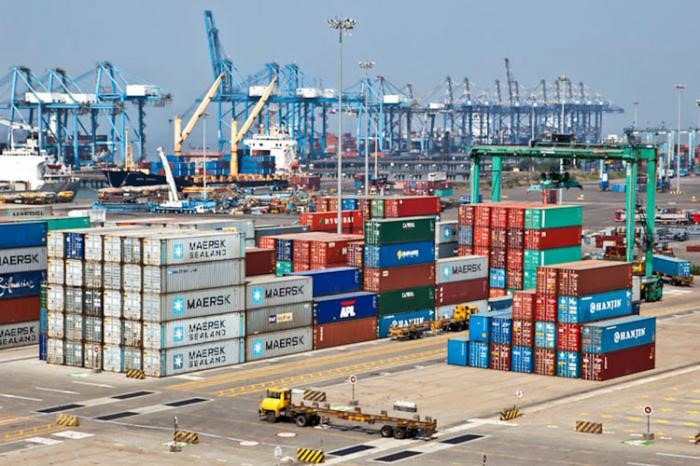
According to trade analysts, the decreased trade deficit is attributed to the government’s policy to reduce imports, decrease trade, increase in palm oil exports and a long-lasting monsoon.
“The country has been witnessing a gradual decline in imports after the government jacked up import duties on luxurious goods including vehicles and imposed restrictions on some products,” said economist Gyanendra Adhikari.
As part of its efforts, the Nepal Government doubled the excise duty on automobile imports and increased the down payment on automobile loans by 50 percent of the vehicle value.
“The data paints a rosy picture of a rise in exports, but the figures have risen mainly because traders have been importing crude palm oil and refining it for export to India. The seasonal export of cardamom has also pushed up the numbers ,” Adhikari further said.
During the review period, Nepal export palm oil worth NPR 5.7 billion compared to shipments worth NPR 374 million last year.
Cardamom exports increased to NPR 707 million from NPR 687 million in the previous year.
On the other hand, Nepal has witnessed a decrease in the import of commodities such as ginger, iron wire, non-alloy steel, scarves, shawls, textile floor coverings and woolen carpets.
Adhikari says that Nepal’s imports shrunk due to the fall in trade volume on account of high interest rates on overdraft loans and a prolonged monsoon.
Fat and milk-based oil imports have also declined drastically due to import restrictions and fuel imports have fallen by NPR 7.52 billion compared to last year.
Nepal has also held a series of trade talks with neighboring countries such as Bangladesh, Bhutan, India and China, resulting in a reduced trade imbalance.
“This has also enabled the exporters to benefit from the simplification in the transit operations and eased the customs procedures in these countries,” said Dhakal.
Export Incentives
The government had also increased the export incentives on Nepal’s major exportable items to 3-5 percent from 1-2 percent from December 2018.
According to the Industry, Commerce and Supplies Ministry , the government provides export incentives to the goods having at least 50 percent value addition inside Nepal.
Dhaka cites factors such government’s revision in the rate of export incentives, simplification of the banking procedures to receive the incentives and extension in the basket of exportable goods for the incentives for a decreased trade deficit in Nepal.
The post Nepal Records Reduced Trade Deficit of 12.2 Pc in First Quarter of Current Fiscal appeared first on Nepali Sansar.
]]>The post Nepal External Sector Deteriorates Following Rising Trade Deficit appeared first on Nepali Sansar.
]]>Despite a steady economic growth rate over the last three years, some of Nepal’s macroeconomic indicators show that all is not well with the country’s external sector.
According to Nepal Rastra Bank’s (NRB) recent update, the country’s Balance of Payments (BoP) has fallen by NPR 67.4 billion in FY 2018-19 compared to the surplus of NPR 960 million earned in FY 2017-18.
Alarmingly, Nepal registered a BoP deficit throughout the last fiscal year owing to the increasing trade deficit, along with no earnings in terms of foreign currency.
Nepal recorded a rise in merchandise imports by 13.9 percent to NPR 1,418.54 billion in 2018-19.
On the other hand, the country’s exports increased by a smaller margin of 19.4 percent from NPR 97.11 billion. This imbalance between imports and exports resulted in an increased trade deficit of NPR 1,321.43 billion during 2018-19.
On account of this, the foreign exchange reserve (forex) fell to NPR 1,038.92 billion in mid-July, from NPR 1,102 in the same period during FY 2017-18.
However, Nepal portrayed a steady remittance growth in FY 2018-19, which increased by 16.5 percent to NPR 879.27 billion in comparison to 8.6 percent in 2017-18. But it is worth noting that there is a decline in the number of Nepali migrant workers in recent years, which is likely to result in a decline in the remittances earned over the years to come.
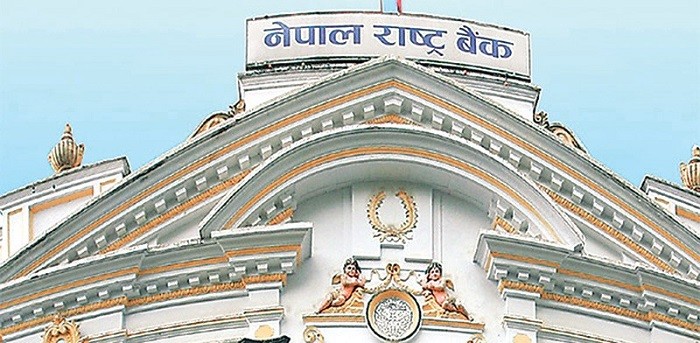
Economists question whether the government will be able to maintain the economic growth rate, which is largely based on consumption.
They suggest that the government should create a favorable environment to attract private sector investment and foreign direct investment (FDI) to shift Nepal’s remittance and consumption-based growth to an investment and productivity-driven one.
Speaking about FDI, Nepal’s FDI Inflow decreased to NPR 13.07 billion in 2018-19 from NPR 17.51 billion in 2017-18.
The private sector investment also took a hit due to shortage of funding in the banking sector. Interest rates of banks increased, making it increasingly difficult for business firms to draw funds.
Also Read:
The post Nepal External Sector Deteriorates Following Rising Trade Deficit appeared first on Nepali Sansar.
]]>The post Nepal’s Solution to Swelling LPG Imports- Electricity appeared first on Nepali Sansar.
]]>However, the expansion of LPG in Nepal has its own downsides. The revenue earned on each cylinder (NPR 1,375) is collected by the Nepal Oil Corporation (NoC) plus a sizeable sum goes to the Nepal Government as tax. Furthermore, some of the money is earned by India in terms of import earnings, contributing to Nepal’s already widening trade deficit.
India buys gas from Gulf countries where Nepali migrants make up for a remarkable size of the Gulf workforce. Indirectly, their income sent in the form of remittance is given back to the countries they work for.
LPG imports contributes to 2.5 percent of Nepal’s total import bill of NPR 1.5 trillion. This is a large amount, especially after Nepal imported 400,000 tons of LPG, last year. Nepal’s LPG imports in February 2019 alone was more than 35,000 metric tons.
Not just the monetary losses, but Nepal is also guilty of contributing to the greenhouse gases.
Besides this, Nepal is also spending a considerable amount of money on the delivery of these cylinders across the country.
The Solution?
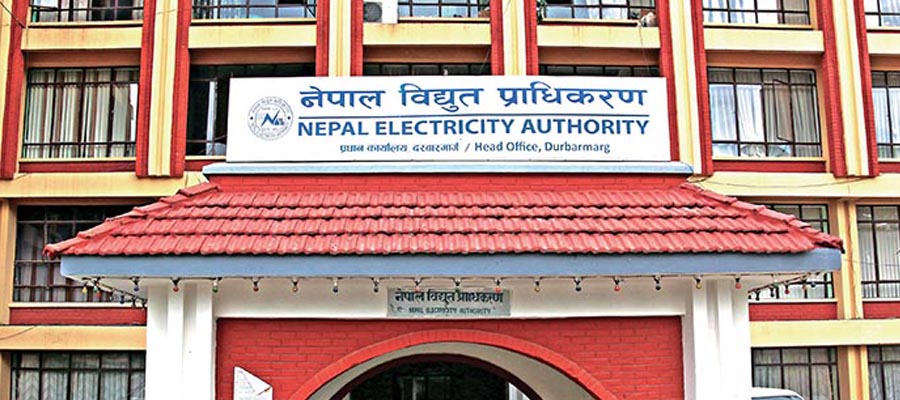
It’s time to consider the potential of energy. Nepal produces its own fair share of clean hydroelectricity. The Khulekhani reservoir reached its maximum level, following rains this year in Nepal. This is where Nepal should take its opportunity and cut away from its dependence on LPG for cooking. Instead of LPG stoves, Nepalis should adopt the usage of electric rice cookers and induction stoves at least during the daytime.
Cooking at least one meal of rice in electric cookers, pre-heating water using solar water heaters can save Nepal a lot of money spent on imports of LPG and energy.
The Nepal Electrical Authority (NEA) can also support this cause by introducing time-of-the-day metering. The cost of the hydropower should vary during the day, peak hours in the evening and night. This will serve as an incentive to cook at certain hours of the day.
It’s time that Nepal also considers using the energy it generates rather than exporting it until it has more than enough for itself.
Soon differential tariff and real-time meters will become defining parameters. Extensive number of hydropower projects and speed of progress towards project completion are synonymous of hydropower’s reliability in terms of cost and quality.
If we only dedicate our time to using electricity for cooking during the day, it can save billions of Nepal expenditure on imports.
The post Nepal’s Solution to Swelling LPG Imports- Electricity appeared first on Nepali Sansar.
]]>The post Nepal FY 2018-19: Remittance Inflow Rises by 29 Percent, External Sector Takes Dip! appeared first on Nepali Sansar.
]]>As per Nepal Rastra Bank’s (NRB) report titled Current Macroeconomic and Financial Situation of Nepal, the remittances inflow increased by 28.5 percent in the review period compared to an increase of 1.7 percent in the same period during 2017-18.
Surprisingly, despite a significant decline in the number of workers applying for work permits in recent months, the total amount of money transfers made by Nepali communities abroad has gone up noticeably.
The number of Nepali migrants travelling abroad decreased by 39.2 percent in the review period, while it went down only by 4.9 percent in the same period, last year.
Experts opine that the following factors have led to the rise in Nepal’s remittance inflow:
- The rising use of formal channels for remittances in countries such as South Korea and Japan
- The elimination of informal channels for money transfer
Nepal External Sector Performance

Meanwhile, the NRB report also states that the country’s external sector continues to disintegrate. The total trade deficit increased by 27.1 percent to NPR 780.19 billion in the first seven months of 2018-19.
Likewise, the export-import ratio also declined to 6.4 percent in 2018-19 from 7.2 percent in the same period during the previous fiscal. The current account registered a deficit of NPR 166.24 billion in the review period. In comparison, the previous year displayed a deficit of NPR 142.09 billion.
The overall balance of payments (BoP) showed a deficit of NPR 49.32 billion in the review period compared to NPR 18.28 million in the review period during 2017-18.
Nepal’s foreign direct investment (FDI) slid to NPR 5.15 billion in the first seven months of FY 2018-19, compared to the previous year’s FDI of NPR 14.34 billion.
The gross foreign exchange reserves (forex) also reduced to NPR 1,078.36 billion until mid-February 2019 from NPR 1,102. 59 billion until mid-July during the last fiscal.
Let’s wait and watch how the country is able to tackle its rising trade deficit and other external aspects in the remaining five months of the current fiscal.
For more important Nepali business news updates, visit our website.
The post Nepal FY 2018-19: Remittance Inflow Rises by 29 Percent, External Sector Takes Dip! appeared first on Nepali Sansar.
]]>The post Nepal-India Trade Treaty Review Meeting 2019 appeared first on Nepali Sansar.
]]>Senior officials from Nepal and India met at Pokhara to review the 2009 Trade Treaty signed by both countries.
The two-day meeting is the second Nepal-India Joint Secretary-level meeting since 2009, where India will respond to Nepal’s proposal of updating the treaty submitted in the first meeting in August 2018.
As part of the meeting, Nepal and India discussed various of interest pertaining to trade, business and connectivity.
The Indian delegation was headed by Department of Commerce Joint Secretary (South Asia) Bhupinder Singh Bhalla, while the Nepali delegation is represented by Ministry of Industry, Commerce and Supplies Joint Secretary Ravi Shankar Saiju.
Request for Access to Additional Indian Ports
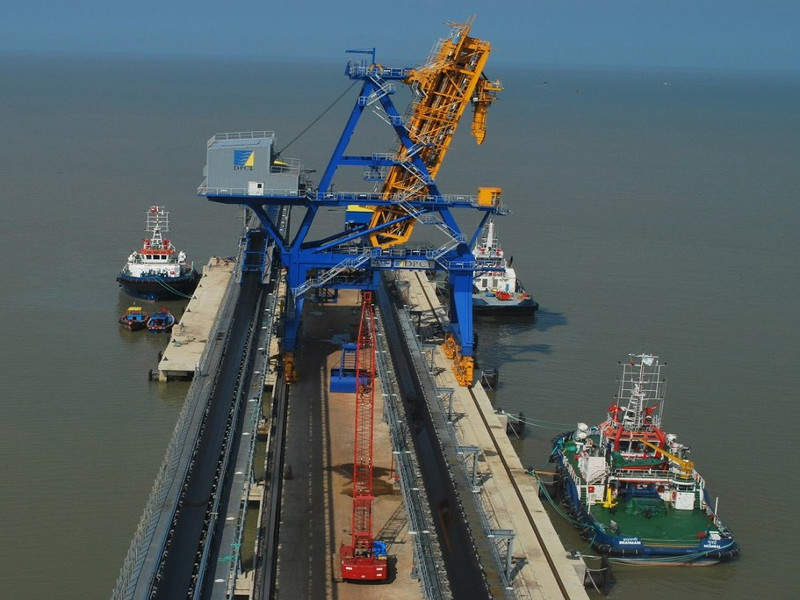
Nepal has requested Indian side to give it access to two additional Indian ports for shipment of its goods.
While the Himalayan nation already has access to Visakhapatnam and Kolkata ports, they have made proposal seeking access to Mundra Port of Gujarat and Dhamra Port of Odisha.
“Nepal has presented a proposal to have access to two additional ports, namely the Mundra port in Gujarat and Dhamara port in Odisha. The Indian side has given a positive reaction over the proposal but a concrete agreement is yet to be made,” said an official from Nepal’s Ministry of Industry, Commerce and Supplies.
Amendments to the India-Nepal Treaty 1990 was one of the key agendas of this Joint Secretary level meeting held in Pokhara.
Other Trade-related Matters Raised
Nepal also sought India’s help in reducing its rising trade deficit through free access of Nepali products in the Indian market.
“Nepal’s trade deficit, especially with India, is constantly widening while our products are finding it difficult in finding proper space in the Indian market. We plan to discuss in detail on how to address these issues through the bilateral trade treaty,” informed Ravi Shankar Saiju, joint secretary at MoICS.
During the two-day trade treaty review meeting, Nepal also raised about giving the Nepali side preference for export of agricultural products and integration of Nepali manufacturing units to its value chain.
Additionally, the Himalayan nation also sought India to review the preference erosion and reciprocity in import & export of agricultural goods and some manufacturing products listed in the treaty.
Despite the treaty’s zero-tariff export facility on different Nepali products, Indian authorities have been imposing various additional taxes on Nepali goods. The Nepali side will also bring this up for discussion at the two-day meeting.
The meeting discussed various options to address different non-tariff barriers in Nepal-India trade and enhancement of Nepal-India connectivity through railway, waterway and roadway.
The post Nepal-India Trade Treaty Review Meeting 2019 appeared first on Nepali Sansar.
]]>The post Nepal’s Oli Govt in 2018 – Achievements, Failures and Questions Unanswered! appeared first on Nepali Sansar.
]]>The Nepal Communist Party (NCP) Chair and Nepal Prime Minister KP Sharma Oli was received amidst opposition parties’ critical uproar in the Parliament on January 06, 2019.
This was the first time Oli addressed a parliamentary session ever since the winter session began on December 26, 2018.
PM Oli’s speech focusing on his government’s efforts for Nepal’s progress throughout the first year of his regime spanned higher growth, curbed-corruption, and improved law and order situation.
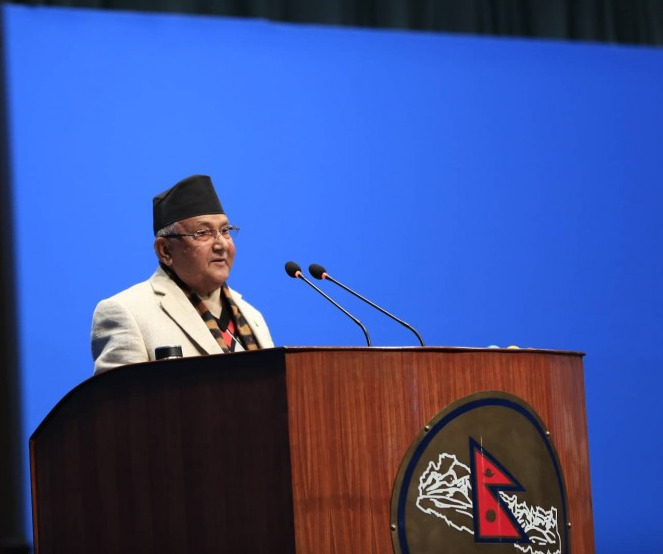
However, Oli’s presentation of Nepal’s progress path didn’t seem to satisfy its main opposition Nepali Congress (NC), whose lawmakers were quick to sought clarifications.
NC lawmakers Dilendra Prasad Badu and Minendra Rijal were first to seek permission from Speaker Krishna Bahadur Mahara to speak to Oli. But the Speaker refused their request after Oli clearly stated that he did not want to take any questions from the opposition.

A number of lawmakers from Oli’s own NCP opined that his parliamentary address was ill-timed and could have waited until his party completed its first term in office.
PM Oli emphasized seven indicators of the budget implementation and their status during the parliament including the balance of payment, capital expenditure, economic growth, employment revenue collection & financial situation, implementation of flagship program and progress made in the implementation of national pride projects.
Following are the major points presented by Oli at the Parliament:
- Nepal’s revenue collection increased by 32% in the first five months of the current fiscal Y-o-Y
- Capital expenditure increased by 25.33 percent in the first five months of the review period while government expenditure reduced to 14 percent from 34 percent last year
- Inflation rate decreased to 3.7 percent from 4.2 percent in the previous year
- Foreign aid increased by 162.72 percent compared to last year, whereas the total pledged foreign aid and loan stands at NPR 112.13 billion
- Nepal exports in the first five months of FY 2018-19 increased by 12.3 percent
The government decided to grant five percent concession on 15 exportable goods and three percent on 11 exportable items to promote export
- National Pride Project Gautam Buddha Airport in Lumbini has been fast-tracked to conduct a test flight by June 2019 with a deadline of six months for the apron and runway construction
- Works on the Upper Tamakoshi project for test production to be conducted by August 2019 are being carried out
- A detailed project on the EastWest Railway has been completed and resources are being arranged for railway construction in the Kakadvitta-Butwal section
Energy:
- Oli said that since this government’s formation, electricity meters have been installed in 30,000 houses and electricity theft was reduced by 3 percent
- In terms of clean energy, biogas plants were installed in 10,561 households including 80,990 solar plants and 40,362 improved stores
- With the Nepal government’s initiative, India amended its energy trade directives enabling Nepal to provide surplus electricity to third countries through India
- The government forged an agreement between Bangladesh and Nepal on electricity trade
- As part of its initiatives, the Oli-led government is working on war-footing to finish the laying of petroleum pipeline between Nepal and India before the deadline
Railway:
Providing the status on railway achievements he said:
- The prefeasibility study on Kerung-Kathmandu railway has been completed and works are underway to prepare a detailed project report
- Preparations for a prefeasibility study of Kathmandu-Pokhara-Lumbini railway are underway, with support from China
- Nepal government has signed an agreement to prepare a Detailed Project Report for Raxaul-Kathmandu railway with India’s support
- Preparations are underway for establishing Nepal Sheep Office and appointing a Sheep Registrar
The Prime Minister also added that a Public Transportation Authority will be formed to manage post-syndicate turmoil in the transportation system. He hailed his administration’s efforts to control crime stating that the Police Administration achieved 96 percent success in curbing crimes.
However, Oli’s report failed to discuss some of Nepal’s major concerns, for which, he received severe criticism from opposition parties and raised questions on his role.
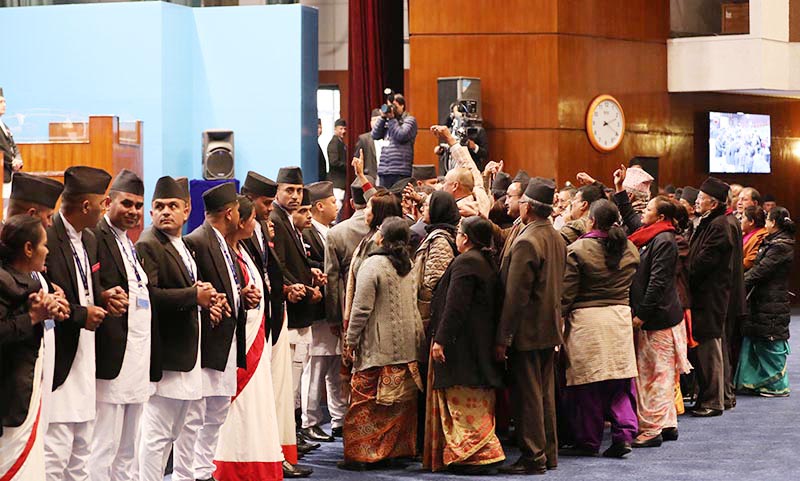
Downsides of PM Oli’s Rule
Following are the discrepancies observed in Oli’s presentation:
- Indifference to Business Community: Finance Minister Khatiwada and Industry Minister Matrika Prasad Yadav failed to be empathetic towards the business community’s problems despite three leading private sector’s umbrella bodies’ attempts to pressurize the incumbent government for creating favorable investment climate.
- Nepal Aviation Scam: Oli irked many when he didn’t comment or speak anything about the NPR 4.35 billion aviation scam. The case stands as one of the biggest corruption scams in Nepal at a time when Oli advocates his government’s attempts to restore good governance and eradicate corruption.
- Rising Trade Deficit: Nepal’s growing trade deficit has been a matter of concern for quite some time. However, PM Oli made no mention about the alarming trade deficit and declining foreign direct investments. The two concerns were one of the commitments that two-thirds of the government pledge to improve during its budget speech. Nepal’s trade deficit stands at NPR 458.48 billion in the first four months of FY 2018-19 and has tipped off the country’s Balance of Payment (BoP).
- According to Nepal Rastra Bank’s Current Macroeconomic and Financial Situation of Nepal report, the country’s export-import ratio dropped to 6.1 percent from 7.4 percent in the last fiscal year.Oli advocated that the trade deficit increased by only 1.5 percent in the first three months of the current fiscal but without any supporting statistics.
- According to the NRB report, the country’s overall BoP in the first four months stood at a difference of NPR 57.33 billion compared to the surplus of NPR 2.40 billion in the same period last year.
“Import of industrial goods and construction material has increased by 40.6 percent and this has hit the balance of payment. But this is a positive indicator for the country’s production and development,” reads an excerpt from Oli’s speech.
- Capital Expenditure Progress: Nepal’s capital expenditure made slight progress but attested that the government failed to deliver its promises of ensuring higher growth and employment. The capital expenditure remained at NPR 26.01 billion compared to NPR 17.86 billion in the previous year. Statistics until Sunday projected a 15 percent progress in the capital spending plan of NPR 313 billion even though more than half the review period has passed by.
- Drop in Foreign Direct Investment: Nepali witnessed a decline of over 50 percent in the first four months of the fiscal despite government claims about improving the FDI flow in Nepal by clearing legal and policy hassles. Nepal’s FDI flow trickled to NPR 4.95 billion from NPR 10.17 billion during first four months of the previous year. PM was quick to defend this claim with a sharp remark stating that the number of foreign investments increased by 25 percent. However, Oli 14-page document failed to attest related numbers.
- National Pride Projects: Most of the national pride projects works remain unsatisfactory. However, Oli pointed the progress in several projects including Babai Irrigation Project, Bheri Babai Diversion Project, Gautham Buddha International Airport, Pokhara International Airport, and the Upper Tamakoshi project.Despite Oli’s attempts to fast-track the project’s final works on his trip to Dolakha in April 2019, the project has failed to make headway. Oli claims that 97.5 percent of the project work is complete however, he did not provide any progress figures when he assumed office. Nepali Congress leader Gagan Thapa said that the information presented by PM Oli was similar to Finance Minister Khatiwada’s White Paper presentation of Nepal’s Economic status.
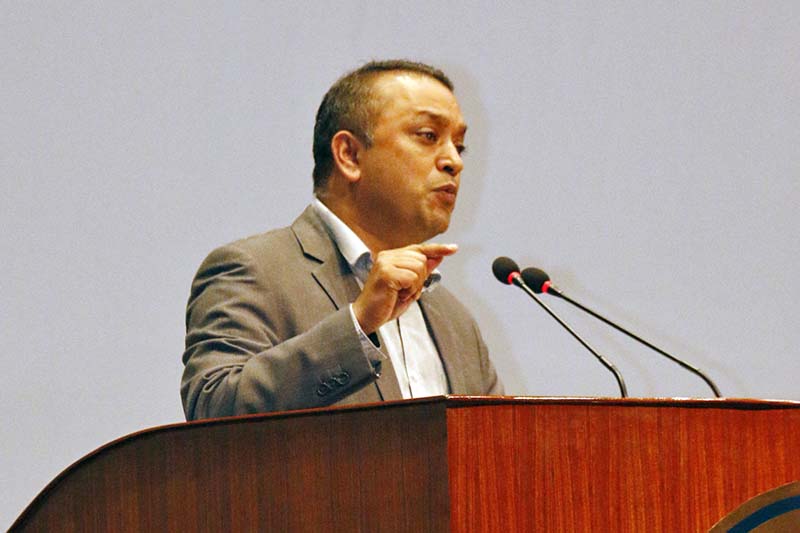
“The White Paper had tweaked economic information to fit Khatiwada’s approach to show the economy in a bad shape, and Oli has now done the same. Oli has manipulated information in his speech. He has also tried to threaten his critics about the procurement of project war room in his office,” said Thapa.
- Nepal Migrant Workers to Malaysia: Thapa further pointed out at the situation of Nepal Migrant workers to Malaysia which is still at standstill despite a MoU being signed by both nations.
“Oli remains silent why the outflow of migrant workers to Malaysia has not yet started but claims that the remittance collection has grown due to administrative reforms,” adds Thapa.
PM Oli states that the number of migrant workers declined by 41 percent but the remittance inflow increased by 36 percent.
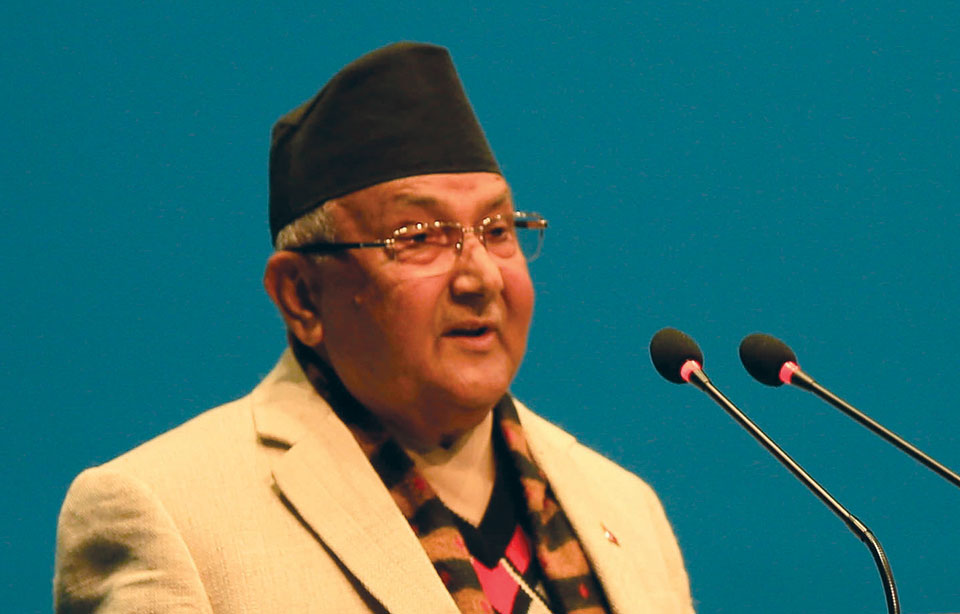
Besides, while Oli presented a good picture of Nepal’s economy at the beginning of his speech, it’s a well-known fact that just nine months before this statement, Finance Minister Yubaraj Khatiwada introduced a white paper which depicted a shoddy state of the country’s economy.
Other untouched/less discussed issues include 13-year old Nirmala Pant’s case and President Buda Devi’s purchase of expensive means of transport including a helicopter.
The meeting portrayed Oli’s contributions to Nepal’s progress in very poor light. Many have begun to raise questions on his ability as Nepal’s Prime Minister.
“The thumping of desks by NCP lawmakers was muted today, which indicated Oli’s performance had deteriorated,” remarked Thapa.
The post Nepal’s Oli Govt in 2018 – Achievements, Failures and Questions Unanswered! appeared first on Nepali Sansar.
]]>The post Nepal’s Alarming Farm Produce Target Raises Concerns appeared first on Nepali Sansar.
]]>The country will fail to meet its agricultural product target in accordance with the 14th Agriculture Development plan.
Nepal projected an increased paddy harvest this year besides corn, paddy, and vegetables.
However, major items such as egg, fish, fruits, legume, meat, potato and wheat failed to meet their respective targets.
According to Ministry statistics, following are the products with their production performance in 2018-19:
- Nepal produced 3.08 million potatoes against the target of 3.25 million
- Wheat production stood at 1.94 million tons against the targeted 2.21 million tons
- Pulses with a total of 369,000 will fail to meet the target of 438,000 tons
- The amount of meat so far will not meet the target by 70,000 tons
- Alarmingly, milk and fish fail to meet the target margins by 509,000 tons and 12, 870 tons, respectively
Looking at the current situation, analysts say that the country’s attempts to curb the deepening trade deficit through milk and meat production will be futile.
Paddy and Vegetables Exceed Targets
Paddy performed exceptionally well when compared to last fiscal 2017-18. The total amount of paddy produced this year was 5.6 million metric tons compared to 5.1 million metric tons last year.
However, it fails to meet Nepal’s overall demand which stands at 6.1 million metric tons.
Ministry Secretary Yubakdhoj GC said that rains, timely arrangements for fertilizers, use of hybrid seeds and the minimal damage caused from natural disasters were the key contributors for the boost in paddy production.
Province 2 was the highest producer of paddy this year with a produce of 1.49 million metric tons, recording an increment of 209,000 metric tons.
In terms of vegetables, Nepal produced 4.1 million metric tons against the target 4 million metric tons. Let’s see if the country will be able to meet its target before the end of the fiscal year 2018-19.
The post Nepal’s Alarming Farm Produce Target Raises Concerns appeared first on Nepali Sansar.
]]>The post WTO Unhappy With Nepal Trade Environment Progress appeared first on Nepali Sansar.
]]>The World Trade Organization (WTO) criticized the country on its incapability to boost its production and trading capacity in the global market.
In its secretariat report prepared during Nepal’s second Trade Policy Review (TPR), WTO pointed that the delay in formulation of important policies could impede Nepal’s trade.
The WTO Secretariat also expressed concern over the bill on safeguards, anti-dumping and countervailing measures that is yet to be presented in Parliament.
“Despite a major transformation in institutional and regulatory arrangements, the key development objectives and related laws remain largely the same as in 2012 when the first TPR was done,” reads the WTO report released in Geneva, Switzerland on December 03, 2018.
TPR is an important component for WTO member countries under which they need to rehash their trade policy at given intervals, which is six years for least developed countries (LDCs) such as Nepal and two to four years, respectively.
Reasons for Delayed Implementation
Nepal identified its long-standing political instability as the reason for lack of enforcing necessary laws to boost its trading environment.
“In other cases, the laws may have been passed, but the implementing regulations are still being drafted. Moreover, in some cases, where the laws and institutions are in place, there is little data on enforcement, such as the laws relating to intellectual property rights, government procurement and competition policy,” the report said.
Nepal has put into effect Trade Facilitation Agreement and the Protocol Amending the TRIPS Agreement.
However, it is yet to become an Information Technology Agreement member and the Government Procurement Agreement.
Despite arduous efforts to meet WTO notification requirements, many of them still remain unfulfilled including some related to subsidies, customs valuation, domestic support for agriculture, import licensing and services.
WTO also brought up the declining participation of Nepal’s manufacturing sector in its Gross Domestic Product (GDP).
According to the world trade authority, the manufacturing sector’s contribution to GDP steadily declined to 5.4 percent in 2017-18 following a decade long period.
The contribution’s decline was attributed to high transport costs, low labor productivity and poor labor-employer relations leading to strikes and production stoppages caused by power outages.
WTO also pointed at the poor regulations implementation to boost market competition.
Nepal had endorsed the Competition Promotion and Market Protection Act 2007 and its Implementing Regulation 2010 that prohibit anti-competitive agreements, abuse of dominant position, mergers and amalgamations with the intent of restricting trade, bid-rigging and other anti-competitive activities.
While the legal and institutional framework is in place, the Act has not been used to prosecute a case.
Instead alternate laws are being practiced in about 30 competition-related cases.
Due to Nepal’s slow progress in removing constraints, Nepal is witnessing a deepening trade deficit.
According to the Trade and Export Promotion Centre (TEPC), Nepal’s trade deficit increased to NPR 454.47 billion in the first four months of the current fiscal year mainly because of a large import bill against a minimal increase in export earnings.
When Secretary Ghimire presented Nepal’s TPR report on December 03, 2018, nine WTO member countries raised 137 queries on Nepal’s trade environment’s improvement status.
According to Nepal’s Permanent Mission to the United Nations press statement, Ghimire and his team answered 128 queries while assuring that Nepal was working on fulfilling its commitments to WTO.
The post WTO Unhappy With Nepal Trade Environment Progress appeared first on Nepali Sansar.
]]>The post Nepal Not Tapping on WTO Trade Privileges: Ministry of Industry appeared first on Nepali Sansar.
]]>As per the Trade and Export Promotion Centre (TEPC), Nepal’s Trade deficit increased to NPR 454.47 billion in the first four months of the present fiscal as the export on tariff-targeted goods was unsuccessful in balancing trade.
Commerce Secretary Chandra Kumar Ghimire pointed that there is no such issue in accessing international markets.
“However, Nepal has failed to improve its products’ quantity and quality to meet the growing demand in the global markets,” Ghimire said in a press meet on November 29, 2018.

Ghimire with a team will be attending the Trade Policy Review (TPR), a mandatory component for WTO members in Geneva on December 13, 2018.
According to the protocol, all member countries need to revisit their trade policy at specific intervals. For least developed countries such as Nepal, the review period is every six years. While developed and developing countries have to review their policy every two and four years.
Nepal is reviewing its trade policy for the second time since it became a WTO member in 2004.
During the first TPR in 2014, Nepal implemented ASYCUDA World (Automated System for Customs Data) at 11 border crossings as part of the customs reforms program.
Likewise, Nepal has endorsed the following:
- Nepal Electricity Regulatory Commission Act
- Power Purchase Guideline
- Guidelines for Development of Grid Connected Alternative Energy
- Trade Policy 2015
- Foreign Investment and One-Window Policy 2015
- National Tourism Strategy 2016-25 among others
- Companies Act 2017
Nepal is among 36 Least Developed Countries listed by the WTO. These countries are provided the following privileges:
- Duty-free access under the Generalized System of Preference
- Permission to export products with a minimum of 25 percent value addition
- Increase tariff temporarily to safeguard domestic industries in case of an import stage
“On the other hand, Nepal should come up with setting its own norms on import items, to check the growing imports,” he said.
Ghimire also stressed the need to comply with standards and regulations mandated by importing countries to boost local products exports.
The post Nepal Not Tapping on WTO Trade Privileges: Ministry of Industry appeared first on Nepali Sansar.
]]>The post Rising Imports Cause Trade Deficit to Nepal appeared first on Nepali Sansar.
]]>As the latest reports say, the country’s trade deficit widened 40.3 percent in the first four months of the current fiscal year, majorly attributed to the rise of imports by the agriculture and fuel goods.
According to Nepal Trade Export Promotion Council, the trade deficit was measured at NPR 454.47 billion as of mid-November 2018, with exports of tariff-targeted goods balancing the trade.
While the import bill is soaring at NPR 483.75 billion, showing a 38.1 percent rise over the previous record, the export earnings showed a little rise of 10.6 percent up to NPR 29.28 billion.
Overall, the export-to-import earning ratio shows exports standing at NPR 1 /- against import expenses of NPR 16.5/-.
Over dependence on imported goods, as a result of challenges in production and supply, resulted in this widening trade deficit, says Suyash Khanal, Deputy Executive Director, TEPC.
“Although exports of yarn, carpet, iron products, tea and textile are getting better, they are not enough to balance the ever-increasing trade deficit,” Suyash adds.
Fuel, the Biggest Contributor to Deficit
Fuel stands out to be the biggest contributor the trade deficit. Nepal’s petroleum product imports in the first four months of the current fiscal amounted to NPR 69.07 billion in revenues, showing a rise over 68.2 percent, year-on-year.

Iron & related products are second in the list accounting to NPR 58.2 billion worth imports during the four-month period, up 62 percent Y-o-Y, majorly due to high infrastructure & reconstruction activity across the nation, adds Khanal.
Nepal’s agricultural imports are next in the list growing in costlier. According to TEPC, the share of agro & petroleum imports was 30 percent of the total import bill during the review period of the current fiscal.
Export Earnings
Yarn exports witnessed a new high of 19 percent to NPR 2.93 billion during the first four months of the fiscal year, with around 13 percent contribution to the export basket. Woolen carpet exports also increased 17.9 percent to result in NPR 2.76 billion earnings.

Readymade garment is another area that contributed to export earnings with 12.1 percent rise to NPR 2.40 billion in revenue.
Import aside, iron & related products also contributed to exports by showing a 47 percent rise to NPR 2.21 billion.
According to Khanal, Nepal needs to make strategies for promotion of its products in the international market for good incomes and balanced trade. He reports positive signs in promoting tariff-targeted goods.
“We must diversify our export basket, particularly handmade goods which are in high demand in the overseas market, so that our export shipments increase rapidly,” adds Khanal.
Meanwhile, Posh Raj Pandey, Executive Chairman of the South Asia Watch on Trade, Economics and Environment, noted that the country should start exploring niche markets to expand their export earnings.
“Nepal needs to sign bilateral agreements to promote export of specific goods to the countries where their demand is growing,” Pandey adds.
The post Rising Imports Cause Trade Deficit to Nepal appeared first on Nepali Sansar.
]]>